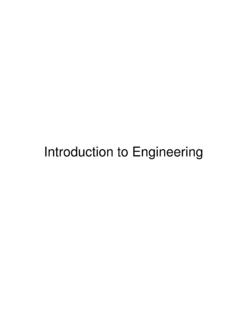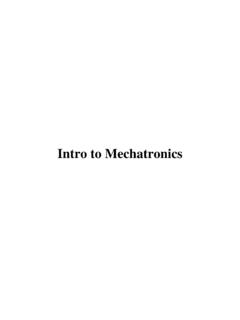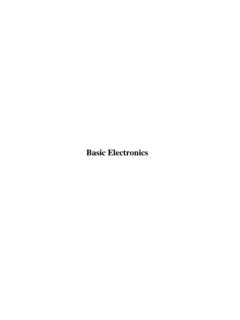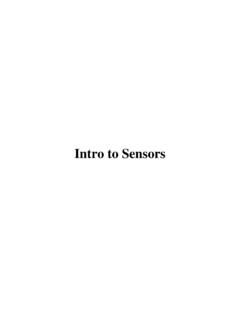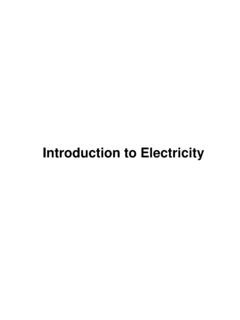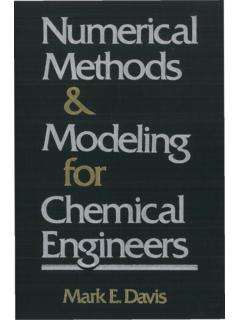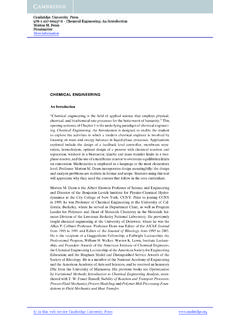Transcription of Intro to Mechanical Engineering
1 Intro to Mechanical EngineeringMech. Eng. Top 10: ASME SurveyAutomobile: High-power lightweight engines, efficient mass-manufacturingApollo: Saturn V launch vehicle ( million pound thrust), command and service module, lunar excursion modulePower generation: Conversion of stored energy into electricity, manipulation of chemical -, kinetic, potential-, and nuclear-energy, large-scale power productionAgriculture mechanization: Powered tractors, mechanized harvesting, high-capacity irrigation pumps, computerized crops managementAirplane.
2 Propulsion (jet engines), lightweight materials, electromechanical control systemsMech. Eng. Top 10: ASME SurveyIntegrated circuit mass production: IC manufacturing machines, alignment systems, temperature-and vibration control, motors, bearings Air-conditioning and refrigeration: Compressors, refrigerants, heat exchangersComputer-aided Engineering technology: Computer-aided design, analysis, manufacturing, virtual collaborativesBioengineering: Imaging, prosthetics, minimally invasive surgery, tissue engineeringCodes and standards.
3 Interchangeability, interoperability, interconnectivityMech. Eng.: Typical ProgramThermo-Fluids: Heat transfer, Energy Systems, HVAC, IC EnginesMechanical Systems: Vibrations, Feedback control, Mechatronics, MEMSD esign: Composites, Machine Design, FEMCore: Statics, Dynamics, Thermodynamics, Fluid mechanics, Solid mechanics Linear motion motion in a straight line (example: train on a track) Reciprocating motion linear motion that goes back and forth (example: pushing a slider-crank back and forth, such as the piston in an internal combustion engine) Rotary motion circular motion (example: the hands of a clock moving, or a wheel on an axle) Oscillating motion circular or arc-motion back and forth (example: the swing of a pendulum or the turning and release of a doorknob)Types of MotionMachine Components.
4 Basic ElementsInclined plane wedgeSlider-CrankCam and FollowerGear, rack, pinion, and sprocketLeverLinkageWheel/AxleSpringsInc lined PlaneWedge Wood PlaneWorm Gear ScrewLeverExcavatorPianoWeighing ScaleScissorsWheel and AxleTurbineWindmillWaterwheelBelt and PulleyElevatorCraneChain HoistGearsSpur GearHelical Gear Bevel GearRack and PinionCamsTranslating CamOscillating CamCylindrical cam End CamSpringsLeaf SpringWasher SpringFrictionBrake SystemBearingForces in StructuresForces and ResultantsFFxFy Rectangular Form: F=Fxi+FyjPolar Form.
5 F= F < >Fx=Fcos( ), Fy=Fsin( ) F = (Fx2+Fy2), =tan-1(Fy/Fx)Moment of a Force IThe moment of a force is a measure of its tendency to rotate an object about some pointMoment of force W about pivot point: W dMoment of a Force IIBalancing Beams using moment of forcesEquilibrium of Forces & MomentsObject in equilibrium 000xyoFFM BuoyancyForce produced by fluid pressureWhen an object is fully or partially immersed in a fluid, due to the pressure difference of the fluid between the top and bottom of the object, buoyant force acts on the object causing it to floatThe net upward buoyancy force is equal to the magnitude of the weight of fluid displaced by the body Buoyancy is important for boats, ships.
6 Balloons, and airshipsDrag ForceForce that resists the motion of an object through a fluidDrag force arises from the motion of an object through fluidDrag force arises from the flow of fluid past an objectAn object moving through a fluid experiences a force in direction opposite to its motion. Terminal velocity is achieved when the drag force is equal in magnitude but opposite in direction to the force propelling the forces arises as a fluid flows around a structureLift force acts perpendicular to the direction of flowMechanical EnergyElastic Potential Energy: Energy stored by an object when it is stretched or bent.
7 21,: spring constant, spring stretch/compression2 Ukxkx Kinetic Energy: Energy associated with an object s ,: mass of object, speed of object2 Umvmv Gravitational Potential Energy: Energy stored by an object as it gains elevation within a gravitational field,: mass of object, sgravitational constant, : elevation of objectUmghmgh Work & PowerWhen a force F acting on an object displaces it by distance d, the force F is said to have done work WWfd Power is the rate at which work is performedWPt Newton s Laws of Motion1stLaw: Every body continues in its state of rest or of uniform motion in a straight line unless it is compelled to change that state by an external force2ndLaw.
8 The rate of change of momentum of an object is proportional to the force acting on the object and is in the same direction as that force3rdLaw: To every action there is an equal and opposite reactionFm a Equations of MotionmxF IM Translational motionRotational motion I1 MnM,x x 1F nFm
